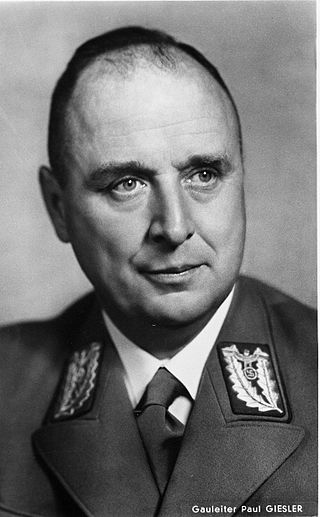The Gau from 1933 to 1945
With the ascent of the Nazis to power on 30 January 1933, the so-called Machtergreifung , the party immediately began to disassemble the power of the German states, the Länder. It was envisioned by the Nazis that the Party-Gaue would take the place of the old structure. In reality, Hitler was afraid of such a move, fearing it would upset local party leaders and could possibly result in an inner-party power struggle. [6]
In Augsburg, the Swabian capital, the Nazis did not gain a strong foothold straight away, only having received 33% of the votes at the 1933 elections. Wahl even interceded with Hitler not to dismiss the mayor of Augsburg, unsuccessfully. [7] Nevertheless, their rise to power there could not be stopped either and by 1941, the party had 39,000 members in the city. [8]
Gradually, the Gauleiter (English: Gau Leader) took control over their territories, reducing the local Minister Presidents , nominally the highest office in the German states, to figureheads. As such, the development of the Gau from a form of inner-party administration to a political and administrative sub-division of the country was gradual, not sudden, but completed by 1934. [2] The process termed Gleichschaltung took care of all political opposition and the "Law on the Reconstruction of the Reich" of 30 January 1934 can possibly be seen as the final date for the transfer of power from the states to the Gaue.
In Swabia, a relatively small Gau, the local Gauleiter Wahl had to initially fend off attempts by his more powerful neighbor, Adolf Wagner, Gauleiter of the Munich-Upper Bavaria region, to incooperate Swabia into his Gau. [6] Wahl was actually the only one of the Bavarian Gauleiter not to have graduated from University. [9] Unlike Wagner, who was a personal friend of Hitler's, Wahl wielded no real influence with the party leadership.
The Gauleiter was directly appointed by Hitler and only answerable to him. In practice, Hitler interfered little in the affairs of the local leaders and their power was almost absolute. [2]
Parallel to the five Bavarian Gauleiter, a Bavarian Minister President still existed during this time, the Nazi politician Ludwig Siebert and, after his death in 1942, his successor, Paul Giesler. As a third authority in the still existing state, Franz Ritter von Epp held the office of Reichsstatthalter but wielded no real power. [9]
Swabia did not have a concentration camp within its boundaries but its close proximity to Dachau meant, that many of its subcamps were in the Gau. Swabia was also home to the Ordensburg Sonthofen , an elite Nazi training facility. [10]
As of 1938, Augsburg had around 900 Jews living within the city boundaries and was home to a magnificent synagogue, destroyed during Kristallnacht on 10 November 1938. It also had 200 Jewish men sent to Dachau that day. In the following years, the Jewish population of the city was gradually deported to concentration camps, that of 3 April 1942, numbering 128 persons, being the largest deportation since the Kristallnacht. Outside of the capital, the Jewish population of Swabia was small, only Memmingen and Nördlingen having substantial numbers. [11]
After the forced addition of Austria to the Reich in March 1938, small parts of the former country were added to the south of the Gau Schwaben, specifically the Jungholz region.
With the outbreak of the Second World War, the power of the Gauleiters, and therefore the power of the Gaue compared to the state government, increased. Many of the Gauleiters were put in charge of the war effort in their Military District (German: Wehrkreis ). [12] Swabia, with its capital Augsburg, was a vital place for the war effort, being home to the manufacturers MAN AG and Messerschmitt. For this reason, Augsburg suffered heavily under allied bombing raids. [8] Many of the companies in Swabia and Augsburg which were in some way involved in the war effort also used slave labour to be able to continue producing. [13] A large number of those died through exhaustion, mistreatment and allied air raids on the production facilities. A monument in Augsburg remembers those victims of the Nazi regime. [14]
As the war progressed and Nazi Germany grew more desperate, the Gauleiters were put in total control of the war effort in their Gau. On 16 November 1942 Wahl, along with all Gauleiters, was named a Reich Defense Commissioner (Reichsverteidigungskommissar). [15]
In September 1944, the Gauleiters were ordered to form the Volkssturm in a last effort to mobilise all of the male population. Near the end of the war in April 1945, Wahl and Swabia were subordinated to Paul Giesler, the Gauleiter of Gau Munich-Upper Bavaria, who was named Reich Defense Commissioner - South and, in addition to his own Gau, was placed in charge of Swabia and three of the formerly Austrian Gaue (Reichsgau Salzburg, Reichsgau Upper Danube and Reichsgau Tirol-Vorarlberg). [15]
In the last days of the war, Karl Wahl made no effort to prevent the hand over of Augsburg to the allies. Shortly after, he was arrested. [16]








